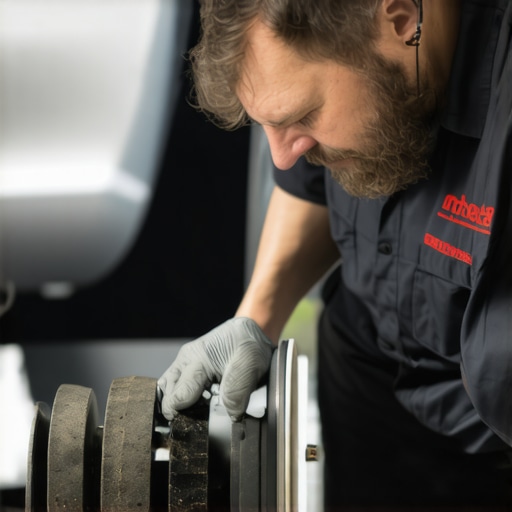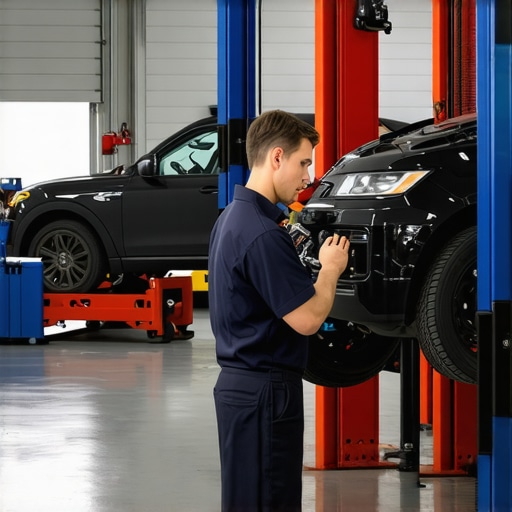When I First Realized the Importance of Reliable Brakes and Engines
I’ll never forget the day I ignored that squealing sound under my car. It was a wake-up call that led me down a path of learning about brake and engine maintenance. As someone who loves road trips and spending time on the open road, ensuring my vehicle’s safety has become a top priority.
Discovering the Secrets of Effective Brake Service
Through my experience, I learned that regular brake inspections are crucial for safe driving. I started following expert advice from award-winning auto services, like those shared on this comprehensive brake maintenance guide. It was eye-opening to see how simple tasks like checking brake pads and fluid levels can prevent costly repairs and ensure my safety on the road.
Understanding the Heart of Your Car: The Engine
My journey also involved diving deep into engine care. I found that understanding the importance of timely oil changes and engine diagnostics can extend your vehicle’s lifespan significantly. The top engine repair tips provided by auto experts have been invaluable for me. They taught me how to spot early signs of engine trouble and when to seek professional help.
What Makes a Car’s Brake and Engine Systems Truly Reliable?
How do I know when it’s time for professional repair or maintenance?
Good question! From my experience, listening to your car’s sounds and paying attention to warning lights can save you money and stress. Regular inspections, especially before long trips, are essential. Moreover, consulting trusted sources like auto service experts can guide you in making informed decisions about repairs and maintenance.
If you’re like me, eager to keep your vehicle in top shape, I highly recommend staying proactive with your car’s brake and engine care. Remember, safety on the road starts with proper maintenance. Feel free to share your experiences or ask questions in the comments below—I love hearing from fellow car enthusiasts!
The Critical Link Between Brake and Engine Maintenance for Safe Driving
As an automotive enthusiast and seasoned mechanic, I know firsthand how integral proper brake and engine care are to vehicle safety. While many drivers focus on routine oil changes, neglecting the brake system can lead to dangerous situations, especially on long trips or in emergency braking scenarios. Similarly, a well-maintained engine is essential for reliable performance and fuel efficiency. Combining these aspects into a comprehensive maintenance strategy can significantly reduce the risk of breakdowns and accidents.
Decoding the Signs of Imminent Brake and Engine Failures
Proactive maintenance begins with recognizing early warning signs. For brakes, persistent squealing, a soft pedal, or vibrations during braking might indicate worn pads or low fluid levels. On the engine side, rough idling, decreased power, or warning lights are red flags. Regular inspections, especially before heavy usage periods, are vital. Consulting trusted sources like this comprehensive brake maintenance guide can help you understand specific checklists and maintenance intervals.
How Can Advanced Diagnostics Improve Your Vehicle’s Reliability?
Modern diagnostic tools have revolutionized vehicle maintenance. They allow mechanics to pinpoint issues with high precision, reducing unnecessary repairs and ensuring that repairs are timely. For example, engine control units (ECUs) can detect subtle malfunctions that might not be visible during a visual inspection. Integrating regular diagnostics with your routine maintenance schedule—like oil changes and brake inspections—is a game-changer. For detailed guidance, check out this top engine repair and oil change guide.
What Role Do Quality Parts Play in Long-Term Reliability?
Using high-quality replacement parts during repairs is essential. Cheap, aftermarket components may save money initially but can compromise safety and longevity. For brakes, investing in OEM or high-grade aftermarket pads and rotors ensures consistent performance. Similarly, high-quality engine components like filters and fluids extend the lifespan of critical systems. Remember, the right parts combined with professional installation make all the difference.
Can Routine Maintenance Prevent Costly Repairs?
Absolutely! Regular check-ups, including brake fluid flushes and oil changes, can catch issues early. This preventive approach minimizes the risk of sudden failures that could leave you stranded or, worse, in an accident. For a detailed maintenance schedule, I recommend reviewing the expert advice at this ultimate guide to oil change and car maintenance. Staying proactive not only ensures your safety but also saves money in the long run.
Have you ever faced a situation where a minor maintenance check saved your trip or prevented an accident?
Sharing real-life experiences can help fellow drivers understand the importance of regular vehicle care. If you’re curious about specific maintenance routines or want personalized advice, don’t hesitate to ask in the comments or share your stories. For more insights, explore our detailed guides on top brake service tips and essential oil change tips.

Understanding the Fine Balance Between Brake Sensitivity and Engine Performance
Over the years, I’ve realized that maintaining a vehicle isn’t just about routine checks; it’s about understanding the intricate dance between different systems. For example, I once noticed that my brake pedal felt softer after an engine tune-up. It prompted me to explore how brake and engine systems influence each other, especially in modern vehicles where electronic controls are intertwined. This experience deepened my appreciation for how subtle changes in one system can impact another, emphasizing the importance of a holistic maintenance approach.
How Do Modern Diagnostics Detect Subtle System Failures Before They Become Critical?
Modern diagnostic tools have become my trusted allies. They can reveal tiny anomalies, like slight variations in brake fluid pressure or engine sensor readings, that might escape the naked eye. For instance, using advanced diagnostics, I once caught an early sign of caliper sticking, which if left unchecked, could have led to uneven brake wear and compromised safety. According to this authoritative guide, integrating diagnostics into regular maintenance routines is vital for preemptive repairs. It’s like giving your vehicle a health check-up before symptoms appear, saving money and ensuring safety.
What Are the Subtle Signs That Your Parts Are Approaching the End of Their Lifespan?
Beyond obvious symptoms like squealing or warning lights, I’ve learned to pay attention to less apparent cues. For example, a slight increase in brake pedal travel or a faint engine rattling noise can indicate worn components. These subtle signs often precede major failures, and recognizing them requires experience and attentive listening. High-quality parts, as discussed in this essential guide, tend to show wear more slowly, giving you a longer window for intervention. Regular check-ups, combined with an ear for the vehicle’s whispers, can dramatically prolong your car’s lifespan.
How Can I Balance the Cost of Quality Parts with Long-Term Savings?
Investing in premium parts initially might seem costly, but it pays off in the long run. I’ve found that OEM or high-grade aftermarket components, although pricier, provide consistent performance and reduce the frequency of repairs. For instance, high-quality brake pads resist warping and fade better under heavy use, preventing costly rotor replacements. Similarly, using top-tier engine oil and filters, as recommended in this detailed guide, can prevent engine deposits and extend service intervals. The key is to view these expenses as investments—each dollar spent on quality parts and diagnostics adds years to your vehicle’s life and safety.
What Personal Lessons Have I Learned About Preventive Maintenance and Peace of Mind?
One of the most valuable lessons I’ve learned is that proactive maintenance isn’t just about avoiding breakdowns; it’s about peace of mind. When I prioritize regular inspections, fluid changes, and system checks, I drive with confidence, knowing I’ve minimized risks. This mindset has transformed my approach from reactive to preventive. I encourage fellow enthusiasts to share their stories—has a small check saved you from a bigger problem? Or perhaps a diagnostic revealed an issue before it became urgent? These personal experiences reinforce the importance of consistent care. Feel free to comment below or explore more about comprehensive vehicle maintenance for added peace of mind.
Deciphering the Impact of Electronic Control Units on Modern Brake and Engine Synergy
In my journey as an automotive enthusiast, I’ve observed that the integration of Electronic Control Units (ECUs) has transformed how brakes and engines communicate, especially in vehicles equipped with advanced driver-assistance systems. These ECUs manage everything from anti-lock braking (ABS) to traction control and engine performance, creating a complex web of interactions that demand an elevated level of maintenance vigilance. Regular software updates, as recommended by manufacturers, are now as crucial as physical inspections. For those interested in delving deeper into how these systems interplay, consulting authoritative sources like NHTSA’s comprehensive guide can offer invaluable insights.
How Do I Detect Subtle Sensor Malfunctions Before They Disrupt Performance?
Sensors are the unsung heroes in modern vehicles, continuously feeding data to ECUs to optimize brake and engine functions. I’ve learned that subtle discrepancies—like a slight delay in brake response or unexpected fluctuations in engine RPM—can signal sensor issues. Advanced diagnostic tools, capable of reading sensor outputs and ECU logs, have become indispensable in my maintenance routine. Recognizing these early signs, such as inconsistent brake pedal firmness or erratic throttle response, can prevent more significant failures down the line. Incorporating routine sensor calibration and firmware updates, as detailed in this expert guide, ensures your vehicle’s systems remain finely tuned.
Balancing Cost and Quality: Strategic Investment in High-Performance Parts
When it comes to long-term reliability, investing in high-quality parts during repairs isn’t just a luxury—it’s a necessity. I’ve found that OEM components, although initially more expensive, tend to outperform aftermarket alternatives in durability and compatibility, especially for critical systems like brakes and engine internals. For instance, premium brake rotors and pads resist warping under heavy braking, maintaining performance and safety. Similarly, high-grade engine oils and filters, as outlined in this comprehensive guide, extend engine life and improve efficiency. Strategic selection of parts, combined with professional installation, forms the cornerstone of a resilient vehicle maintenance plan.
Integrating Proactive Diagnostics for Peak Vehicle Performance
Modern diagnostic technology is a game-changer, allowing me to preemptively address issues that might otherwise go unnoticed. Regularly scanning my vehicle’s systems with advanced tools reveals early signs of wear—such as slight increases in brake fluid pressure or subtle engine sensor anomalies—that could escalate into costly repairs if ignored. This proactive approach aligns with recommendations from industry-leading auto service experts. By integrating diagnostics into routine maintenance, I ensure my vehicle remains in optimal condition, reducing downtime and enhancing safety.
Leveraging Data Analytics to Predict System Failures
Beyond individual diagnostics, data analytics has become a vital tool in my maintenance arsenal. By analyzing patterns over multiple service intervals—such as frequency of brake pad replacements or engine performance trends—I can predict impending failures and plan interventions proactively. This predictive maintenance approach, supported by insights from authoritative sources like NHTSA’s vehicle maintenance strategies, ensures my vehicle’s longevity and safety. Embracing this data-driven methodology transforms routine care into a science, minimizing surprises and maximizing reliability.
Ready to Elevate Your Vehicle Maintenance Strategy?
If you’re passionate about extending your vehicle’s lifespan through sophisticated maintenance techniques, I invite you to share your experiences or ask questions. The journey toward mastery is ongoing, and exchanging insights can be immensely rewarding. Explore more about how strategic investments and cutting-edge diagnostics can safeguard your driving experience by connecting with expert resources and community forums dedicated to automotive excellence.
Things I Wish I Knew Earlier (or You Might Find Surprising)
Hidden Signs of Brake Wear
One thing I learned the hard way is that subtle noises like faint squeals or a soft pedal can be early indicators of brake issues. Paying attention to these small signals can save you from costly repairs and dangerous situations. I wish I had known to trust these tiny cues earlier.
The Overlooked Power of Regular Oil Changes
It’s tempting to delay oil changes when everything seems fine, but I’ve realized that timely oil and filter replacements are the backbone of engine health. Skipping this routine can lead to deposits and decreased performance, which might surprise many drivers.
Why Quality Parts Matter More Than You Think
Using high-quality replacement parts, especially for critical systems like brakes and the engine, makes a noticeable difference. I found that OEM parts, even though pricier, tend to last longer and perform better, ultimately saving money in the long run.
Modern Diagnostics Are a Game-Changer
When I started using advanced diagnostic tools, I was amazed at how early they could detect issues. Reading sensor data and ECU logs helped me prevent problems before they became serious, and I highly recommend integrating diagnostics into your maintenance routine.
Resources I’ve Come to Trust Over Time
- National Highway Traffic Safety Administration (NHTSA): Their comprehensive guides on vehicle safety and diagnostics helped deepen my understanding and are a must-visit for anyone serious about vehicle maintenance.
- Auto Repair Experts at Clear Auto Glass: Their detailed articles and tips, such as this brake maintenance guide, are invaluable resources I rely on.
- Automotive Technology Journals: They keep me updated on the latest trends in ECU technology and sensor diagnostics, ensuring my vehicle stays in top shape.
Parting Thoughts from My Perspective
Maintaining reliable brakes and engines isn’t just about safety; it’s about peace of mind. Paying attention to the subtle signs, investing in quality parts, and leveraging modern diagnostics can dramatically improve your vehicle’s longevity and performance. My biggest takeaway is that proactive care, rather than reactive fixes, truly makes a difference. If this resonated with you, I’d love to hear your thoughts or stories about how regular maintenance saved your trip or prevented an emergency. Feel free to share in the comments or pass this along to someone who could benefit from these insights—because good maintenance isn’t just smart; it’s essential for safe, confident driving.

